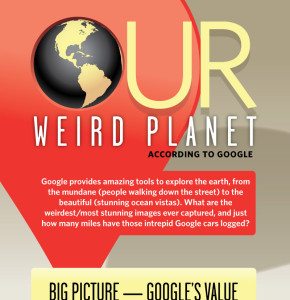Google provides amazing tools to explore the earth, from the mundane (people walking down the street) to the beautiful (stunning ocean vistas). What are the weirdest/most stunning images ever captured, and just how many miles have those intrepid Google cars logged?
Big Picture — Google’s Value
Thanks in part to products like Google Maps and Google Earth, the Mountain View, California-based company is one of the most valuable in the U.S. Here’s a look at the top 10 publicly traded companies in the U.S. by market capitalization (which is the total value of all shares):
Market capitalization (billions of dollars)
Apple $439.39
Exxon $403.32
Google $257.40
Berkshire Hathaway $243.60
Walmart $238.85
General Electric $236.78
Microsoft $233.53
Chevron $228.01
IBM $226.03
Johnson & Johnson $210.06
Google’s Long Journey
5 million+
Miles driven by Google Street View cars
20+ petabytes
Combined size of images the cars have captured
That means the Street View cars have gone enough miles to make more than 10 round trips to the moon and have stored hundreds of times more information than is contained in the Library of Congress.
How It Works
Google engineers work to make the 360-degree panoramas we demand appear totally seamless and immersive. Here’s what they do:
Collect imagery
Cars and trucks fitted with cameras drive around and photograph the locations. Special attention is paid to the weather and population density to determine when and where to gather the best shots.
Align imagery
Each image is matched to its geographic location on the map, so signals from sensors on the car are combined with GPS, speed and direction. This allows engineers to reconstruct the exact route and tilt or realign images as needed.
Create 360-degree panoramas
Cameras take slightly overlapping pictures to avoid gaps, and the images are “stitched” together in a single 360-degree image. Image processing algorithms lessen seams and create smooth transitions.
Did You See That?!
Here’s a look at some of the Google Earth sights that will make you do a double-take.
Top of a bridge
Journey to the top of Japan’s Great Seto Bridge.
School of fish
Travel with a school of fish near Heron Island in Australia’s Great Barrier Reef.
An angel?!
While this is most likely a Google glitch, some paranormal enthusiasts believe it’s a sign of a spirit ascending to heaven.
Death dock?
Reddit users were convinced they’d found a crime scene in what appeared to be a trail of blood; turns out it was a trail of water dragged along the wood of the dock by a wet dog.
Phantom Island
Australian researchers thought they’d discovered an island about the size of Manhattan in the South Pacific. A mysterious place named Sandy Island had popped up on maps and even showed up as a black shape on Google Earth. But when scientists sailed there, they found open water instead of land.
Blood lake
No official explanation has been made yet about a blooded lake outside Sadr City, Iraq.
Where planes go to die
Closed to the general public (but not to satellite imagery), the Davis-Monthan Air Force Base in Tucson, Ariz., contains virtually every plane the military has flown since World War II.
Wild elephants
Run with a herd of African elephants in Chad.
Devil inside?
A five-pointed star surrounded by a circle, seen in an aerial view in Kazakhstan, led many to claim an evil influence. Not so — roadways now lined with trees accentuate the existing star-shaped outline of a park.
Sources:
http://www.livescience.com
http://mashable.com
http://www.google.com
http://www.engadget.com
http://www.theonlineinvestor.com
Carrie Morris
Author
Warren Dahl
Editor-in-Chief


